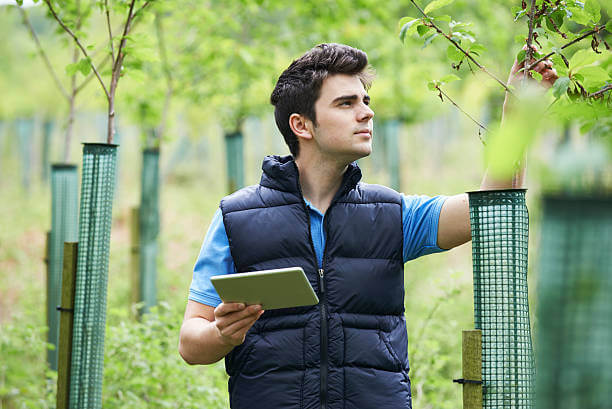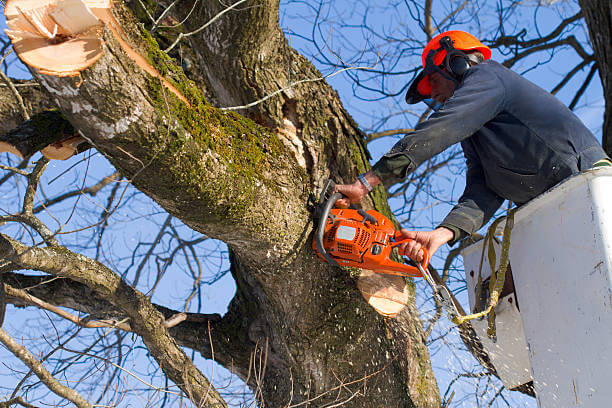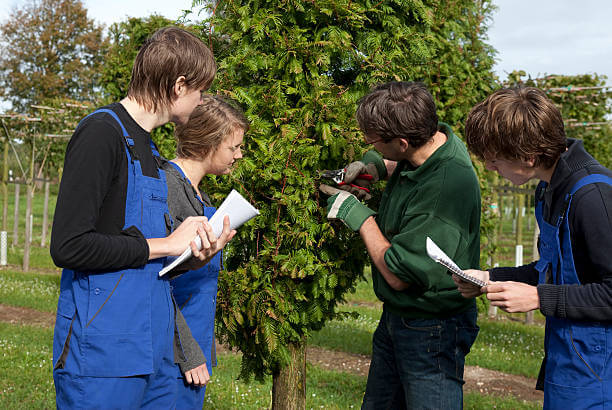To work in the tree service sector and run your own business, you must become a certified arborist. To do that, you will need to take a course in Arboriculture.

The minimum is a Certificate II, but Certificate III or a Diploma in Arboriculture is recommended depending on what capacity you wish to work in.
Below are the three main courses you can take. Everyone needs to start at the beginning, so to do the Certificate III course, you need to have previously completed Cert II in Arboriculture. To do the Diploma course, you need to have the first two under your belt.
Tree health management is essential to ensure the health of your tree long term. Arborist will do it for you.
Courses available
Certificate II – This will give you the basic skills to safely use a chainsaw, work safely on-site and some essential pruning and tree felling techniques. This is perfect for someone wanting the basic skills to work as groundsmen for a tree services company.
Certificate III – This is a big step up in your skill base from Cert II. You will learn climbing techniques and removing trees in confined spaces. You will gain a more in-depth knowledge of trees and how they function, identify pests and treat diseases. This course is perfect for someone wanting to work independently in the tree service industry and run their own business.
Diploma (Cert. V) – This is for the consulting arborist. This is less to do with tree pruning and removal and more to do with arborist reports, tree inspections, pests and disease, etc. This is very intensive and not for the faint-hearted.
Eligibility
Candidates must have three years of experience in
arboriculture or a combination of experience and education. Letter(s) of
reference may be submitted as proof of work experience, and volunteer work may
be used for the background if the work is supervised and documented.
Test Design
A certified arborist has taken additional steps to
understand the why and how of the tree cycle. From growth to the end of life,
an arborist understands the influences and can develop and implement a
life-cycle plan that ensures the proper development of each species. This knowledge
includes fine selection, establishment, and biology of the trees in their
care. There are 200 multiple-choice questions, and you will have
three and a half hours to complete the exam. The time limit and the number of
questions are the same regardless of the test delivery method. There are ten
content knowledge categories:
- Soil management – 12% of the exam
- Identification and selection – 8% of the exam
- Installation and establishment – 5% of the exam
- Safe work practices – 15% of the exam
- Tree biology – 8% of the exam
- Pruning – 16% of the exam
- Diagnosis and treatment – 12% of the exam
- Urban forestry – 7% of the exam
- Tree protection – 4% of the exam
- Tree risk management – 13% of the exam
The exam is intended to test your knowledge over a broad
range of competencies that a general arborist will encounter during their
Career. Certification does not confer legal status to practice and continuing.
education is required throughout your time as an arborist to maintain
certification.

Test delivery method
There are two options available for test delivery.
The option is a traditional pencil and paper examination. The paper-based method is
only offered at a chapter or affiliated organization of the International
Society of Arboriculture (ISA). This method has a predetermined test delivery
schedule, and the exam results may take up to six weeks to receive.
The second method is computer-delivered. Computer-based
exams are administered at a testing facility with the opportunity to schedule
the exam at a time, location, and date that is convenient to the test taker.
While there is an additional $125.00 fee to take the computer-based exam,
results are immediate.
Both the paper-based and computer-based exams are equal in
their difficulty level.
Which method you choose is solely up to you. Are you
better with a pencil in your hand? Then schedule the paper-based exam. Is it
necessary to you to have immediate results? Then the computer-based method is
better.
Registration and cost
Registration is $170.00 for International Society of Arboriculture (ISA) members and $280.00 for non-members for the paper certification exam of ISA Certified Arborist. If you choose to take the computer-based exam, there is an additional fee of $125.00 required. Computer-based exams are scored immediately, and the results are provided after you complete the exam.
Test Day
Verify your testing location and time before you leave for
the exam. Allow yourself enough time to find parking, secure your valuables,
and complete any necessary paperwork before your examination appointment.
Personal belongings and study aids are not allowed in the testing centre. All
supplies needed for the exam will be provided to you.
Exam scoring and results
To obtain certification, you must receive a 76% or higher on
the examination. Each domain is weighted, and the average is not equal to your
overall score. Regardless of the test method, all candidates receive a detailed
report of their test.
The complete report will discuss your strengths and
weaknesses, so you will know where to enhance your study for the future.
You may retake the exam as many times as required, and the first retake is free. Each test after the first free retake cost $75.00 each, within one year of taking the exam the first time. If you have not passed the certification exam within that year, the exam test fee is $170.00 for ISA members or $280.00 for non-members.
How Can I Prepare for the Certified Arborist Test?
That’s a great question. We’ve broken down the answer into three parts.
- Do yourself a favour and study. Do not walk in unprepared. We have recommended prep materials below, but that only helps if you try. Plus, studying is proven to be the best antidote to test anxiety.
- Take care of yourself. Make sure you’re eating well, exercising, and sleeping. All of these things are scientifically linked to brain performance. If you take care of your body, you’ll be helping your grades.
- Get a study guide or set of flashcards. Some people study better a certain way. Find your study strengths and make the most of them. We’ve tried to make it easy for you by tracking down the best study guide and flashcard set for your exam. Below you’ll see links to both!
Looking for a Stump Grinder? Explore our wide range of tree care solutions her
The ISA Certified Arborist Exam
The Certified Arborist Exam is available for qualified arboriculture professionals who want to become Certified Arborists. The Certified Arborist Exam, administered by the International Society of Arboriculture (ISA), is accredited by the American National Standards Institute. Professionals who earn this credential demonstrate professional knowledge of tree biology, safety practices, diagnosis, and other arboriculture-related topics.
There are many advantages associated with earning the Certified Arborist credential. Certified Arborists often have a competitive advantage in the job market because employers and organizations associate this certification with experience and expertise. Becoming a Certified Arborist can also mean an increase in income, depending on the employer. Overall, the ISA Arborist credential can advance the professional development of today’s arborists.
Eligibility Requirements
To apply to become a Certified Arborist, applicants must fulfil at least one of the following requirements.
Experience: Applicants must have at least three years of full-time experience in arboriculture. Some of the many eligible duties include cabling and bracing, fertilization, pruning, and the diagnosis and treatment of tree problems. Example employers include municipalities, landscape companies, tree care companies, and nurseries. Applicants can submit supervised volunteer work as long as they provide documentation providing the hours worked and responsibilities. To validate work experience, candidates must submit a letter(s) of reference from previous or current employers. If the applicant is self-employed, they must submit three letters of reference.
.Education: You may fulfil the eligibility requirements by completing a university accredited degree program with additional practical experience in arboriculture or by completing an assessment-based certificate program. Visit the exam website for more eligibility details regarding education.
ISA Certified Arborist Application Process
Candidates may apply for the Certified Arborist Exam on the ISA website through the “My ISA Dashboard.” After submission, applicants will receive an approval or denial email from ISA. In the approval email, there will be a link to sign up for the exam. After enrollment, candidates who requested a pen and paper exam will receive a confirmation packet with the location, date, and time of the exam, as well as a contact person. Applicants who requested a computer-based exam will receive an email with a link to schedule the test. There is a 90-day authorization period to schedule and take the exam.
ISA Certified Arborist Exam Fees
Applicants who are ISA members, an ISA chapter or an affiliated organization, pay $170 for the exam. The fee for nonmembers is USD 280. If candidates request the computer-based exam, there is an additional $125 administration fee.
If applicants need an additional 90-day authorization period to reschedule the exam, there will be a $50 fee. If candidates are still within their 90-day period, there is no additional fee to reschedule the exam. To reschedule an exam within your 90-day period, please get in touch with the
Arborist Certification Topics
The Certified Arborist Exam, comprising 200 multiple-choice questions, is developed using data gathered from arborists worldwide. Twenty of these questions will not count towards the final score. The exam is divided into ten areas of expertise, which are listed below.
- Pruning (16%)
- Safe Work Practices (15%)
- Tree Risk Management (13%)
- Diagnosis and Treatment (12%)
- Soil Management (12%)
- Identification and Selection (8%)
- Tree Biology (8%)
- Urban Forestry (7%)
- Instalment and Establishment (5%)
- Tree Protection (4%)
What to expect on test day
Applicants will have 3.5 hours to complete the Certified Arborist Exam. The testing location depends on whether candidates take the exam through an ISA chapter, affiliate organization, or separately. Some of the standard procedures and tips are listed below.
- Would you mind arriving at the testing centre 30 minutes before the start of the exam?
- Bring two forms of identification. One I.D. must have a photograph, while the other I.D. must have your signature.
- You are allowed to take bathroom breaks, but that time is considered your exam time.
- Food, beverages, reference materials, books, papers, cell phones, and other mobile devices are prohibited.
If you are taking the computer-based exam, you will receive your test results immediately after the exam. Applicants taking the paper-based exam will receive their results in six weeks. If you pass the test, you will receive a certificate, score sheet, congratulatory letter, identification card, patch, and hard-hat decal. If you do not pass the exam, you have one year from the original test day to retake the exam. The first retake is free, and any retake after that is $75. If applicants retake the test after the one-year window, they are required to pay the total amount, including the $125 administration fee, if taking the computer-based exam.
How to prepare for the ISA Certified Arborist Exam
We understand that preparing for any exam can, at first, be intimidating and overwhelming, so our test-taking experts created the Mometrix Certified Arborist Exam Study Guide. This comprehensive study guide thoroughly explains the key topics found on the exam, including mineral deficiencies, pruning, and backfilling. The Mometrix Certified Arborist Study Guide also includes effective test-taking strategies that are sure to help you quickly eliminate incorrect answers, look out for common answer traps, and so much more!
Studies show that repetition is one of the most effective study strategies, so our experts also developed the Mometrix Certified Arborist Exam Flash Cards. Designed with professional-quality material, these flashcards are ideal for quizzing and studying on the go! Additionally, the Mometrix Certified Arborist Flash Cards are easy to read, allowing you to absorb the information more effectively.
We look forward to assisting you on your journey to becoming a Certified Arborist! We wish you the best of luck!
Certified Arborist Study Guide
Mometrix Academy is a completely free Arborist certification resource provided by Mometrix Test Preparation. If you benefit from our efforts here, check out our premium quality Certified Arborist study guide to take your studying to the next level. Just click the Certified Arborist study guide link below. Your purchase also helps us make even more great, free content for test-takers.
What arborists do and how they charge
Arborists perform a variety of tasks, including
Tree trimming
Tree removal
Stump removal
Arborist reports
Tree inspections
Root pruning
Depending on the task they are performing will dictate how much they charge. As every tree is different, the amount for removal and pruning will vary. We have an excellent resource for tree removal costs and also a tree trimming cost guide.
Arborist reports usually are around $400, depending on the requirements. Still, in most cases, they are in conjunction with a permit to remove a tree from your property or for a development application.
Let Arborist take care of your tree needs. Our arborists provide Tree Cabling & Bracing and other tree services you need.
What tasks will you likely be doing when you start?
Removing a tree sounds easy enough, but there is a lot that goes into it. Just as important as it is to have a skilled arborist climbing the tree to dismantle it piece by piece, the ground crew must support him by lowering branches as he ties them off and cuts them.
After the tree is on the ground, all branches need to be dragged to the front of the property to be chipped in the wood chipping machine.
Depending on the equipment your employer has, you will then need to block up the tree log and carry it out the front to load into the truck.
Other tasks you will perform as an entry-level arborist.
– Dragging branches
– Sharpening saws
– Cleaning/refuelling chainsaws
– Stump grinding
– All-round hard labour
Is it better to be a climber or a part of the ground crew?
Both tasks are hard work and dangerous, but a climber will, on average, get paid two or three times more than the ground crew.
Some days are more complex than others. Some days you won’t feel like climbing, but have to. The incentive is always there, though, because the pay is excellent.
Difference between a Certified Arborist and a regular arborist
Essentially, they are the same thing. A Certified arborist means you have completed a certificate II or III in Arboriculture and now have the skillset to carry out tree pruning and removal work. A regular tree doctor or tree surgeon is still certified.
The reason the distinction is made is that there are a lot of tree services or “garden maintenance” companies who are not qualified arborists and should not be working on trees any more significant than 10 – 15ft. Working at heights when you don’t know what you are doing is extremely dangerous and should only be undertaken by qualified professionals.
All qualified arborists should carry public liability insurance also. If you are not authorised, the insurance company will turn you down. So if you do hire someone who is not qualified or insured, you are leaving yourself wide open to a litigation disaster if they injure themselves on your property.
What are my career opportunities once I graduate?
Graduates may find a career as a:
Head arborist
Crew leader
Arborist climber
Apprentice climber
Consulting arborist
Ground staff member
There are employment opportunities in a wide variety of areas such as:
Commercial tree service companies
Public utility companies
City, county, and other government agencies
Landscape maintenance firms
Nurseries
Garden centres
Industrial complexes
Theme parks/ resorts and private estates
Botanical gardens
Golf courses


